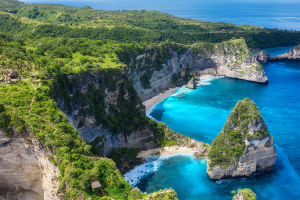Earth is a rocky planet. The lithosphere includes the upper mantle and the entire crust, that is, the lithosphere above the asthenosphere. Its thickness is about 60-120 kilometers. The solid rocks of the Earth exist primarily here, functioning and transforming at the same time.
Rock is composed of one or several minerals and natural glass and is a solid aggregate with stable shape. Rocks composed of one mineral are called monomineral rocks; rocks composed of several minerals are called polymineral rocks.
Rocks can be divided into three categories according to their origin and characteristics, namely igneous rocks, sedimentary rocks, and metamorphic rocks.
Igneous Rock
This type of rock is formed by the solidification and cooling of magma. Extrusive rocks are formed when magma spews out of the ground and solidifies and cools.
Sometimes the magma does not spew out of the ground and solidify, but invades the crust or solidifies before it spews out of the ground. The rocks formed in this way are intrusive rocks.
The most common type of extrusive rock is basalt, which is relatively loose and porous. After the magma spews out of the ground, the gas components in the magma will diffuse due to the pressure being greatly reduced compared to the underground. Therefore, the rocks formed by cooling generally have small pores and are less dense.
Sedimentary Rock
Sedimentary rock is a rock formed by loose sediments such as classics, colloids, and organic matter accumulated layer by layer on land or in the ocean. On the earth's surface, 70% of the rocks are sedimentary rocks.
But if the entire lithosphere is calculated from the surface of the earth to a depth of 16 kilometers, sedimentary rocks only account for 5%. The minerals contained in sedimentary rocks account for 80% of the world's mineral reserves.
Metamorphic Rock
Metamorphic rock is the natural metamorphosis of one stone into another under the mixed action of high temperature, high pressure, and minerals. Qualitative changes may be recrystallization, texture changes, or color changes.
Metamorphic rock is a new type of rock produced by the change and transformation of rock structure caused by the internal force of the earth. These forces include temperature, pressure, changes in stress, and chemical composition.
Solid rocks form new mineral combinations under the pressure and temperature of the earth's interior. For example, ordinary limestone becomes marble due to recrystallization.
Metamorphic rocks are the main components that make up the Earth's crust. Generally, metamorphic rocks are produced under high temperature (greater than 150 degrees Celsius) and high-pressure deep underground, and then exposed to the surface due to crustal movement.
In addition to the three basic types of rocks, there are some special rocks on the earth, such as carbonate rocks, volcanic rocks, tectonic rocks, rock salt, and so on.
Carbonate rocks are rocks composed of carbonate minerals, such as limestone and marble. Volcanic rock refers to rocks formed by volcanic eruptions or erupted magma, andesite, rhyolite, etc. are common.
Structural rocks refer to rocks formed by the deformation of the crustal structure, such as gneiss and granulite. Rock salt refers to rocks composed of salt minerals, mainly composed of pure salt and halenite, which are commonly found in salt lakes, bays, and other areas.
Rocks are the main component of the Earth's crust and the basis for life on Earth. By studying the origin, nature, and characteristics of rocks, we can understand the evolution process and geological structure of the earth, discover mineral resources, and guide mineral exploration and development.


